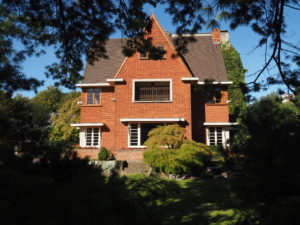Oldgreytravel was passing through Brussels the other day and eschewed the blockbuster museums and sights to find time to take in one of Europe’s finest small museums. Small museums have one obvious advantage for the traveller – they are small and easily digestible in a comparatively short time. They are also cheaper and less crowded than the big national museums.
The Van Buuren House and Gardens is like a timewarp, taking you back to a relatively recent, but now vanished, part of European history. The Van Buuren’s were wealthy, bourgeois art patrons in the tumultuous inter-war years of the C20, and they were Jewish. They had the good fortune to leave Belgium before the Nazi onslaught – the Van Buuren’s being high on the Nazi’s wanted list. The house somehow survived the war unscathed. The artworks, of which there are many, were entrusted to the Van Buuren’s chauffer who hid them in the loft of his own house for the duration. When the Van Buuren’s returned to the house in 1945, the pictures were all back in their place.
The house, gardens and the artworks are all part of one vision. The house, built 1924-28, is relatively small and located in a well to do suburb in the south of the city. The style is reminiscent of much Dutch architecture of the period, not surprisingly perhaps as David Van Buuren was born in the Netherlands and had an active part in the design. It is finished in a distinctive hand-made red brick with steep gables and overhanging cornices and an asymmetrical arrangement to the fenestration. It has echoes of the English Arts and Crafts Style and the fusion of interior and exterior, gardens and house and plan form and decorative arts is typical of the Arts and Crafts philosophy filtered through the eyes of the Amsterdam School of architecture.

The inside of the house is a mix of Art Nouveau and Art Deco with nods to everybody from Frank Lloyd Wright to Japanese design. The interior was conceived as one, in which every piece of furniture, every object or picture was designed to give a perfect balance. Precious as this may seem, the house does not have any feeling of fragility or pretentiousness, nor does it have the stuffiness of a traditional museum. It was designed as a house to live in and the museum maintains that feel of the owners having just departed. You are free to wander at will through the interior, no curators or guards to oversee you and hamper your enjoyment. The mixture of carefully commissioned furniture, textiles, carpets, stained glass and an extraordinary range of contemporary paintings by Flemish artists of the period provide a fascinating insight into the lives of the Van Buuren’s and the lost world of Jewish bourgeois society.
The gardens, surprisingly extensive for such a suburban location, provide the essential backdrop for appreciating the house. Designed as a series of separate “rooms,” they were designed by the leading landscape gardeners of the day under the supervision of Alice Van Buuren.
The Van Buuren Museum is located in the suburb of Uccle in the south of Brussels. Tram 3 from the Gare du Midi (Eurostar) terminates at Churchill just a few minutes walk from the museum.